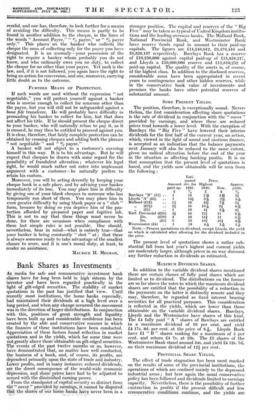Bank Shares as Investments ,
As media for safe and remunerative investment bank shares have for long been held in high 'esteem by the investor and have been regarded practically in the light of gilt-edged securities. The stability of market quotations in the past has justified that view. Until recently most institutions, the home banks especially, had maintained their dividends at a high level over a long period, and when any change occurred the movement was in the direction of larger distributions. In conjunction with this, positions of great strength and liquidity have been built up and considerable confidence has been created by the able and conservative' manner 'in which the finances of these institutions haVe been conducted. Appreciation of these factors found reflection in market quotations and in the yields, which for, some time were not greatly above those obtainable on.gilt-edged securities. The events of the past twelve. months or so, however, haVe demonstrated that, no matter how well conducted, the' business of a bank, and, of course, its ,profits, are dependent primarily upon the state of trade and industry. Lower profits, and in many instances reduced dividends, are the direct consequence of the world-wide economic depression, and share. prices have had to be adjusted to accord with the dimimShed earning power.
From the standpoint of capital security as distinct front. tile." cover " provided by earniti s; it carinotlie disputed; tlist the shares of our home banks haVe never been in a
stronger position. The capital and reserves of the Big Five " may be taken as typical of United Kingdom institu- tions and the leading overseas banks. The Midland Bank, National Provincial Bank, and Westminster Bank have reserve 'funds equal in amount to their paid-up capitals. The figures are £14,248,012, £9,479,416 and £9,820,157 respectively. Barclays Bank has a reserve of £10,250,000 against capital paid-up of £15,858,217, and Lloyds a £10,000,000 reserve and £15,810,252 of paid-up capital. The quality of the assets is, of course, of the highest class. In addition to the disclosed reserves, considerable sums have been appropriated in recent years to contingencies and other hidden reserves, while in the conservative book value of investments and premises the banks have other potential reserves of substantial amount.










































 Previous page
Previous page